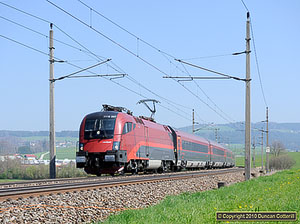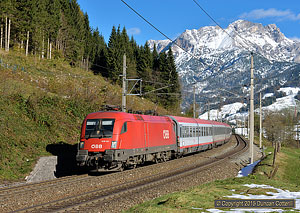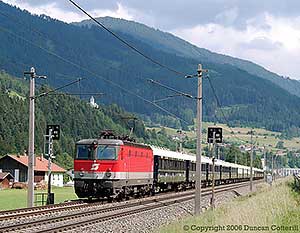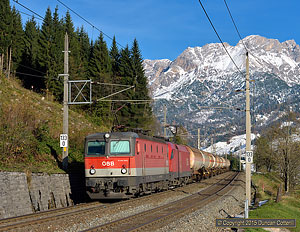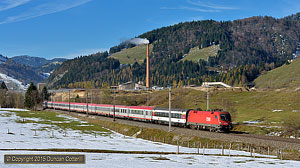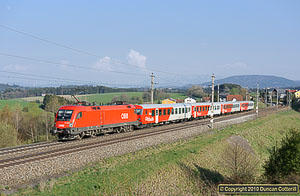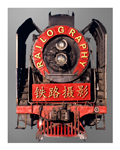101 Salzburg - Linz
11 photos
updated : 2015-07-02
The Salzburg - Linz line is one of Austria’s principal main lines, carrying trains from Innsbruck and München towards Wien. It’s a busy, double-track, electrified route with plenty of loco hauled international and domestic passenger trains and freights, all running through attractive countryside.
200-201 Schwarzach - Wörgl
12 photos
updated : 2015-07-04
The Schwarzach St. Veit - Wörgl line is a very scenic east-west main line between the Vorarlberg and Tirol and the rest of Austria. It's a 126km, double-track, electric route climbing over the 970m Hochfilzen Pass in the heart of the Alps, serving the resort towns of Kitzbühel, St Johann and Zell am See.
300 Brenner Pass
8 photos
updated : 2016-07-06
The electrified double-track main line from Innsbruck over the Brenner Pass is one of Europe's more spectacular main line railways. It's an extremely busy route with local and express passenger trains interspersed with a large volume of international freight traffic, mainly running between Germany and Italy.
Class 1016/1116/1216
21 photos
updated : 2015-09-08
The most common locomotives in Austria these days are Siemens Taurus Bo-Bo electrics of classes 1016, 1116 and 1216, able to operate on 15kV, 15/25kV and 15/25/3kV systems respectively. ÖBB has around 380 in total and other operators' locos can also be seen on Austrian rails.
Class 1044/1144
4 photos
updated : 2015-07-04
Production of the thyristor controlled class 1044 started in 1976 with 217 built by 1995. All but two were later equipped for push-pull operation and reclassified as class 1144. Most are still in service with ÖBB and can be seen all over the Austrian network on secondary passengers and freights.
electric locos
28 photos
updated : 2016-07-06
As late as the 1990s Austria had one of the most diverse and interesting electric locomotive fleets in the world with a few locos dating back as far as the 1930s. Then came the Siemens Taurus, sweeping away all the old machines and leaving only a couple of other classes in widespread use on the network.
freights
9 photos
updated : 2016-07-05
Austrian railways have long carried a healthy volume of freight, much of it international traffic between Germany, or elsewhere in northern Europe, and Italy, eastern Europe or the Balkans. All types of traffic can be seen, including wagonload freight, with most trains concentrated on electrified main lines.
passenger (loco hauled)
20 photos
updated : 2016-07-06
Loco hauled passengers are still relatively common in Austria with most long distance trains and a good number of regional services loco worked. The vast majority of trains are now operated with push-pull equipment and that includes most of the principal expresses, operating under the RailJet banner.
ÖBB
30 photos
updated : 2016-07-06
Österreichische Bundesbahn (ÖBB) is the national railway operator and still runs the vast majority of Austria's domestic and international passenger services. A wholly owned subsidiary, Rail Cargo Austria, was formed in 2005 to separate out ÖBB's freight services and is also included here.
Austria's Alpine scenery and eclectic variety of traction first attracted me to the country in the 1970s. There's less variety now but it's still an attractive country with a reasonable number of loco hauled passenger trains and heavy freight traffic on the major routes.
Austria's railways date back to the first half of the 19th Century and their history is far too long and interesting to go into all the details here. The country was an early adopter of railways, which spread rapidly throughout the Austro-Hungarian empire from the 1830s onwards. The line over the Semmering Pass, widely regarded as the world's first mountain main line, was opened in the 1850s and the country was also one of the first to pioneer main line electrification in the 1920s, using the 15kV, 16.67Hz AC system that's still in use today.
At the time of my first visit in 1975, steam traction was still in use on a handful of standard gauge lines, including the Erzbergbahn, an incredible mountain railway that used 80 year old 0-6-2 rack tanks to drag and shove iron ore trains over the Präbichl Pass. Steam also lasted into the 1980s on a couple of narrow gauge lines.
In those days the electric traction was almost as interesting as the steam with several classes of pre war locos still in widespread use into the 1990s. The introduction of standard classes gradually took its toll and by the early years of the 21st Century most of the variety had disappeared. EMUs have been used in Austria for many years but numbers have been limited until recently and they were largely confined to suburban services around the big cities.
Diesels have never occupied a particularly important place on Austrian railways, with most lines of any significance going straight from steam to electric traction. On less heavily trafficked lines diesel railcars were often used instead of locomotives.
At the time of my first visit in 1975, steam traction was still in use on a handful of standard gauge lines, including the Erzbergbahn, an incredible mountain railway that used 80 year old 0-6-2 rack tanks to drag and shove iron ore trains over the Präbichl Pass. Steam also lasted into the 1980s on a couple of narrow gauge lines.
In those days the electric traction was almost as interesting as the steam with several classes of pre war locos still in widespread use into the 1990s. The introduction of standard classes gradually took its toll and by the early years of the 21st Century most of the variety had disappeared. EMUs have been used in Austria for many years but numbers have been limited until recently and they were largely confined to suburban services around the big cities.
Diesels have never occupied a particularly important place on Austrian railways, with most lines of any significance going straight from steam to electric traction. On less heavily trafficked lines diesel railcars were often used instead of locomotives.




 options
options hide options panel
hide options panel